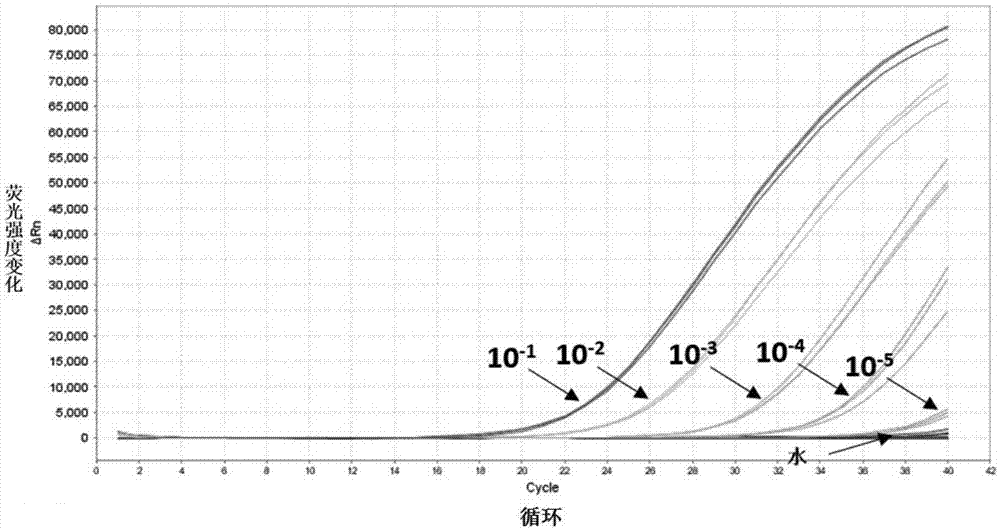Primer and probe for identifying temperature-sensitive type of coral symbiotic photosynthetic algae and identifying method
A temperature-sensitive, photosynthetic algae technology, applied in the direction of DNA / RNA fragments, recombinant DNA technology, etc., can solve the problems of coral symbiotic photosynthetic algae without uniform standards and difficult morphological identification
- Summary
- Abstract
- Description
- Claims
- Application Information
AI Technical Summary
Problems solved by technology
Method used
Image
Examples
Embodiment 1
[0039] Embodiment 1: Separation and cultivation of test algal species
[0040] Collect the helmet coral tissue samples in the sea area of China. The coral tissue is scraped or cut with a scalpel blade, and the extraction buffer (artificial seawater filtered by a 0.45um microporous membrane and 5mM EDTA, 40mg / L ampicillin and 30mg / L Kanamycin), remove the coral tissue from the surface of the skeleton, collect the washing fluid, and shake vigorously for about 3 minutes to destroy the mucus. Centrifuge the above-mentioned host extract at 5000g for 5min, collect the precipitate, suspend and mix with extraction buffer, centrifuge the obtained slurry at 2000g for 5min, discard the liquid, resuspend the precipitate with buffer, and mix. Repeat 2-4 times until the extracted symbiotic algae are pure and save for future use. Take another drop of the suspension solution for microscopic examination (10×10), if there are impurities, repeat the above steps,
[0041] Until the extracted ...
Embodiment 2
[0043] Embodiment 2: the extraction of DNA of algal species
[0044] The algal cells of Example 1 are collected by centrifugation, that is, the algal cells are placed in a 10ml centrifuge tube, 4°C, 13,000rpm, and centrifuged for 15min. After the supernatant is removed, the precipitated bacteria are placed in a sterile ultra-clean work Blow dry. Then, use the CTAB method to extract the genomic DNA of the algae; first, transfer the excess algae collected by centrifugation to a 1.5mleppendorf tube; add 600ul of CTAB extract, place it in a water bath at 65°C for 1 hour, and shake it several times during the period. In order to fully break up the algae cells. Next, remove the centrifuge tube from the water bath, add the DNA extraction solution and an equal volume of phenol, chloroform, and isoamyl alcohol (volume ratio 25:24:1) mixed solution, vortex vigorously for 5 min, and collect the supernatant by centrifugation. Finally, add an equal volume of chloroform / isoamyl alcohol (v...
Embodiment 3
[0045] Embodiment 3: Taqman fluorescent quantitative PCR detection
[0046] Design real-time quantitative PCR primers and Taqman probe combination (FAM-CladeC) according to the specific sequence of temperature-sensitive CladeC of coral symbiotic photosynthetic algae, wherein FAM-CladeC includes one of the following primer-probe sets:
[0047] FAM-CladeC Group 1:
[0048] Primer: FAM-CladeC-F1: 5'-GCTGAACACGGACCCAT-3'SEQ ID NO: 2;
[0049] FAM-CladeC-R1: 5'-GGATGCTTGCGGTGAGATA-3' SEQ ID NO: 3;
[0050] Probe: FAM-CladeC-P1: 5'-AAGGGTTGGTGAGTGTGCATCTGT-3'; SEQ ID NO: 4;
[0051] The second group of FAM-CladeC:
[0052] Primer: FAM-CladeC-F2: 5'-GTGAGTCTGACTTCATGCTAGAG-3'SEQ ID NO: 5;
[0053] FAM-CladeC-R2: 5'-GCTTTGCGCGCTGTTATT-3'SEQ ID NO: 6;
[0054] Probe: FAM-CladeC-P2: 5'-AGCATGAGCAGCGTCACTCAAGTA-3'; SEQ ID NO: 7;
[0055] The third group of FAM-CladeC:
[0056] Primer: FAM-CladeC-F3: 5'-CCACGAAGGTAGAAACCTGAA-3'SEQ ID NO: 8;
[0057] FAM-CladeC-R3: 5'-CCTTGCGTTCTTA...
PUM
 Login to View More
Login to View More Abstract
Description
Claims
Application Information
 Login to View More
Login to View More - R&D
- Intellectual Property
- Life Sciences
- Materials
- Tech Scout
- Unparalleled Data Quality
- Higher Quality Content
- 60% Fewer Hallucinations
Browse by: Latest US Patents, China's latest patents, Technical Efficacy Thesaurus, Application Domain, Technology Topic, Popular Technical Reports.
© 2025 PatSnap. All rights reserved.Legal|Privacy policy|Modern Slavery Act Transparency Statement|Sitemap|About US| Contact US: help@patsnap.com



